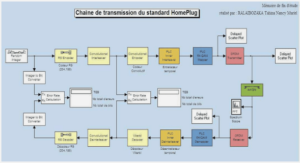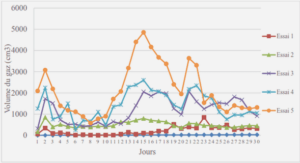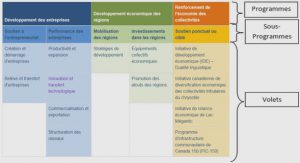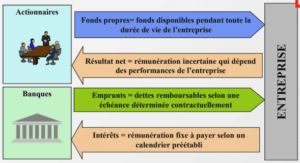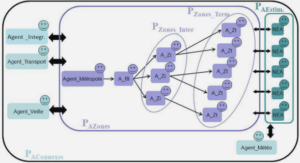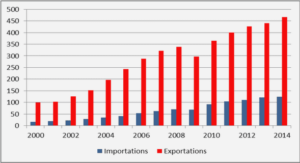Energy Use in Buildings (Past, Present, and Futur)
In the last 20 years, energy consumption in buildings has grown. Sheer statistical increases underlie most of this growth – more people, more households and more oftices. Growing demand for service-more air conditioning, more computers, bigger houses – has also contributed. However this increase has been moderated by the use of new technologies. Energy-efficient materials, appliances, and building designs have lowered residential energy intensity (energy consumption per household per year) and maintained commercial energy intensity (energy consumption per square foot per annum).
In the future, building energy use will be driven by technological change but will also be affected by other factors, including population and economic development, changes in household six, changes in lifestyle, and patterns of migration. The complexity and interactions of these factors make it difficult to predict exactly future levels of building energy use, however OTA estimates that building energy use will continue to grow at a moderate pace in a « business-as-usual » scenario (that is, assuming no policy change). While estimates of the forecasted savings are highly unpredictable, there is general consensus that there is significant technological and economic potential for savings.
Energy and environnement
There is general consensus among climate scientists around the world that the latest strong proof of climate change is 90 percent likely to be due primarily to human activity by fossil-based energy burning. This should be sufficient enough to persuade us that human intervention will eventually put a brake on the advance of global warming and its climatic implications. Buildings are particularly involved in this process, currently responsible for around 47% of carbon dioxide emissions in all 25 countries of the European Union. That being the case, it is appropriate that the design and construction of buildings should be the primary driver of climate change mitigation efforts. The security of the planet rests on our ability and willingness to use this free energy without creating unsavory side effects.
Enviornnement impact
Carbon is the main ingredient of earthly life.The carbon cycle system works on the premise that the carbon that is trappedin plants and animals is released slowly into the atmosphere after they die and decompose. This carbon in the atmosphere is then taken up by plants that transform carbon dioxide (CO2) into roots, trunks, leaves etc.By photosynthesis .While the atmosphere was tropical on the majority of the world and the amount of CO2 was very high, the well-known emission amount of 386 g of CO2/kWh was imposed by gas plants. While the relationship between CO2 concentration, temperature change and adverse climate changes is very complex and therefore very difficult to forecast accurately, it is generally agreed that this concentration does not occur.
The green house effect
The greenhouse effect is caused by long-wave radiation, which is reflected back into the atmosphere by the Crust and then reflected back by trace gasses in the colder upper atmosphere, resulting in further warming of the Earth’s surface. Without the greenhouse effect, the surface temperature of our world would have been-18 ° C The presence of this phenomenon means that the average temperature of the planet is 15 ° C. Our world uses an average of 240 W / m2 to warm up to 13.
Climate change – the paleoclimate record
In June 1990, scientists were sharply drawn by a graph published in the journal Nature. Data from ice core samples shows a surprisingly strong connection between temperature and atmospheric CO2 concentrations from 160 000 years ago to 1989. This has also been shown that the present concentrations of CO2 are higher than at any time during that period. At the very least, the rate of growth has been sustained since then. Core ice samples provide information in four ways. First, their melted layers provide an indicator of the time period of the heart. Second, the calculation of the degree to which the ice melted and cooled during the summer provides a impression of the relative warmth of the season. The third measure is the 18O heavy oxygen isotope in the air trapped in the ice. It’s more common in warm years. Finally, the air trapped in the snow layers makes it possible to measure CO2 in the atmosphere in a given year. Certain ice core data indicate that at the end of the last ice age 20 000 years ago, the sea level was around 150 m lower than it is today.
Bio-climatism and sustainable development
In both aspects, the limited resources and risks associated with unregulated migration, particularly in the poorest countries, the global management of the earth and its ecosystems must be enforced by man. Amid ups and downs in political will and, in particular, significant differences from one country to another, the UN World Commission on Environment and Development could, in its report entitled Our Future for All, say Bruntland report, in 1988, proposing that nations formally adopt the notion of sustainable development is the term consecrated can lead to confusion. Its definition is as follows: « Sustainable development is a social, economic and political development that responds to present needs without compromising the ability of future generations to meet their own development.
This idea illustrates the need, very new in its recognition of international solidarity, solidarity between all the peoples of the world and solidarity between generations. As a result, each player in each sector of economic life is faced with the responsibility for the overall management of resources and the environment.
Improving energy efficiency in buildings
The technological potential for energy savings in buildings is enormous, particularly with »passive » projects that reduce or even remove the need for active energy usage.In cold climate areas , for example, super-isolated and air-tight residential buildings (often referred to as passive houses) use just 10 to 25% of the active heating energy required to heat the average new residential building today. Passive design techniques for buildings in warm climates, such as white roof, sun shading and natural ventilation can also achieve significant cooling load reduction. In addition, market competition and government energy efficiency (EE) policies can lead to new generations of EE equipment that also help bring down the energy use in buildings.
Energy usage and performance in buildings is typically characterized by end-use categories such as space heating , cooling and lighting. In these end-use categories, EE is typically defined by the design and construction (including the materials and components used) of the building and by the technological performance and operational management of energy-intensive buildings. Energy consumption is further influenced by variations in building function, climate, energy prices, billing methods, and human behavior.
There are three primary ways in which energy efficiency can be improved in residential, public, and commercial buildings:
Through improved design and construction techniques that reduce heating, cooling, ventilating, and lighting loads.
Through building upgrades and the replacement of energy-using equipment. By actively managing energy use
The main junctures at which energy efficiency interventions can be launched are as follows:
When designing and constructing new buildings : A building energy efficiency code sets out the minimum energy efficiency requirements of a building. The most effective way to ensure that energy efficiency is included into the design and construction process is by introducing and enforcing Building Energy Efficiency.
By retrofitting existing buildings : Retrofitting existing buildings and replacing energyconsuming equipment are critical for improving energy efficiency in cities. Cities need to be opportunistic in order to capture this potential.
By establishing and maintaining energy management systems : Establishing and maintaining effective energy management systems for monitoring and controlling energy use in large public and commercial buildings is a low-cost means with which to improve energy efficiency and reduce energy demand.
In following these steps, cities can achieve large energy cost savings, help create new businesses and jobs, increase energy security, and improve the quality of life of their constituents.
|
Table des matières
INTRODUCTION
CHAPTER 1 : BUILDINGS,ENERGY AND CLIMATE IMPACT
1.1. Introduction
1.2. Energy in buildings
1.2.1. Energy Use in Buildings (Past, Present, and Futur)
1.2.2. Primary,secondary and final energy
1.2.3. Final energy consumption by type of energy in algeria
1.2.4. Sectors of final energy consumption in algeria
1.2.5. Distribution of consumption residential sector by types of energy
1.2.6. Renewable energy and energy efficiency
b) Energy efficiency
c) Energy efficiency in buildings
1.3. Energy and environnement
1.3.1. Enviornnement impact
1.3.2. The green house effect
1.3.3. Climate change – the paleoclimate record
1.3.4. The Environmental Policy in algeria
1.3.5. Algeria climate
1.3.6. The varriation of temperature in some states of algeria
1.3.7. The Mountain Zones
1.3.8. Desrt
1.4. buildings and environnement
1.4.1. Demography and cities planning
1.4.2. Impact of urban planning
1.4.3. Impact of building
1.5 The bioclimatism
1.5.1. bioclimatic approach
1.5.2. Bio-climatism and sustainable development
1.5.3. Urban ecology
1.5.4. Challenges for urban ecology and the city
1.5.5. The German experience
1.6. Conclusion
CHAPTER 2 : BUILDINGS INSULATION
2.1. Introduction
2.2. The current state of construction in Algeria, from passivity to efficiency?
2.3. Improving energy efficiency in buildings
2.4. The Opportunities
2.5. Barriers and Challenges
2.6. Solutions
2.7. Energy efficiency in new buildings
2.8. Regulation of energy efficiency in new buildings
a) Building envelope
b) HVAC systems
c) Renewable energy
d) Installed equipment
e) Zoning of buildings
f) Integrated design
2.9. Main Modes of Heat Transfer
1. Conduction
2. Convection
3. Radiation
2.10. Definitions of Relevant Technical Terms of Heat Transfer
2.10.1. Thermal Conductivity
2.10.2. Temperature Stability
2.10.3. Strength
2.10.4. Coefficient of heat transmission (U)
2.10.5. Thermal resistance (R-value)
2.10.6.Thermal bridge
2.10.7. Heat loss
2.11. Insulation materials
2.11.1. Thermal insulation to control heat
2.11.2. Acoustic Insulation to control sound
2.11.3. The Sound Absorption
2.11.4. Classification of building insulation materials
2.12. Application of building insulation
2.12.1. Insulation on wall
2.12.2. Insulation on roof and ceiling
2.12.3. Insulation on windows
2.12.4. Insulation on floor
2.13. Characterization of insulation materials
2.13.1. Thermal characterization
2.13.2. Acoustic characterization
2.13.3. Environmental characterization: Life Cycle Assessment
2.13.4. Reaction to fire
2.13.5. Water vapor resistance factor (μ-value)
2.14. Thermal balance
2.14.1. Method of calculation per coefficient G
2.14.2. Method of measurement of the energy balance by the Ubat coefficient
2.14.3. The empiric meaning of Ubat
2.15. Conclusion
CHAPTER 3 : Application, results and discussion
3.1. Introduction
3.2. Goal of the study
3.3. Description of the building
3.3.1. Climatic data of Zenata (Tlemcen)
3.3.2. Geometric characteristics of this building
3.3.3. The technical data of this building
3.3.4. Orientation
3.3.5. Methodology of the study of energy needs
3.4. Simulation tools
3.4.1. Presentation of the DESIGN BUILDER software
3.4.2. Energy plus in design builder
3.4.3. Create Building Geometry
3.4.4. Opaque and Glazed constructions
3.4.5. Lighting
3.4.6. HVAC
3.5. Energy efficiency measures
3.5.1. Types of windows( without insulation)
3.5.2. Types of windows( with insulation)
3.5.3. Presentation of the different constructive elements of the building
3.5.4. The impact of insulation
3.5.5. Permanent sun protection
3.6. Results and Discussion
3.6.1. Simulation results
3.6.2. Discussion
3.7. Conclusion
Perspectives and recommandations
CONCLUSION
![]() Télécharger le rapport complet
Télécharger le rapport complet

